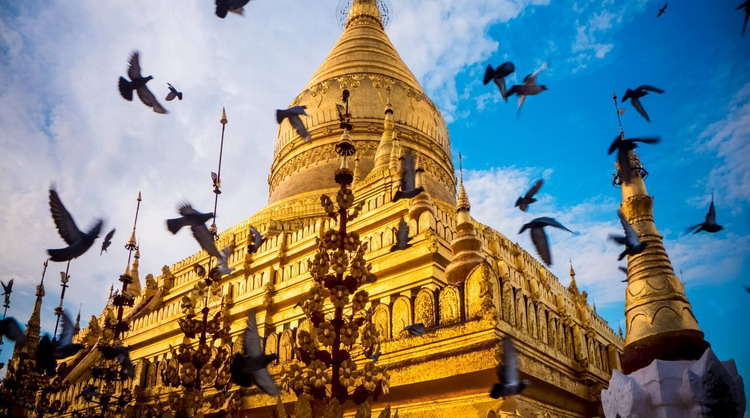Shwezigon Pagoda – The Most Sacred Pagoda in Bagan
The Shwezigon Pagoda in Bagan, which is located near Bagan in the plains at Nyaung U, is a pilgrimage centre. It is one of the most well-known temples of Bagan. According to scholars, the name of this pagoda is originated from “Zeyabon” in a poem on “Nine Wonders of Shwezigon”, so it is called “Zeyakon”. A Bagan travel is really not complete without a visit to Shwezigon Pagoda.

The Nine Wonders of Shwezigon Pagoda

Other Structures on Shwezigon Pagoda Complex
There is a wall with 230 meters on each side surrounding the Shwezigon complex and all fours sides of the complex have an access gate. There is also a big mythological lion standing guard at the main entrance gate.

Another Gold Lion Guarding at a Corner of Shwezigon Pagoda
Some other structures are topped with a Sikhara- a tower like structure. The difference between these Sikharas and the Sikharas of the Ananda temple is that they are not gilded. In the complex, there is also a small white washed pagoda and other structures.
Shwezigon Pagoda Experienced a Long History
Shwezigon Pagoda was built in the 11th century by King Anawrahta with the purpose of enshrining a collection of relics including the Buddha’s frontal and collar bones, a copy of the tooth relic at Kandy, Sri Lanka, and an emerald Buddha image from China.
Probably the most significant aspect of Shwezigon’s history is that it marked the first royal endorsement of the 37 nat (spirits), a central focus of Burmese religion before the arrival of Buddhism.

The pagoda was finished between 1086 and 1090 by King Kyanzittha (r. 1084-1113). It was under him that Bagan became known as the “city of four million pagodas.” The essential shape of Shwezigon Pagoda became the architectural prototype for many other stupas across Myanmar.
Similar to other temples in Bagan, this great pagoda has been damaged by earthquakes and other factors over the centuries.
One unique feature of this pagoda is that it has more than 30,000 copper plates that cover the pagoda, donated by local, national and international visitors to Shwezigon.
What to See at Shwezigon Pagoda?
Shwezigon Pagoda is surrounded by an outer wall, about 750 feet on each side. The pagoda contains many other shrines, stupas and structures within the wall. Two inscribed pillars which are on the eastern side of the complex is one of the most highlighted features of these outer monuments.

You Can See the Particularity of Shwezigon Pagoda’s Outer Wall
Another interesting thing is that its golden “bell” with a height of 160 feet is supported on a square base 160 feet on a side and three square terraces. The bell is decorated with various designs, surrounded by several thick moldings with the traditional jeweled hti (umbrella spire) on top.
There is also the hall of the 37 Nats in the southeast of the platform, with figures of the 37 traditional spirits.

Shwezigon Pagoda is Topped with a Huge Bell
Festivals of Shwezigon Pagoda
For those who are interested in Myanmar travel, the Shwezigon Festival in November/Decembe will be a great chance to explore the culture of Bagan because of its great religious significance for Burmese Buddhism.


